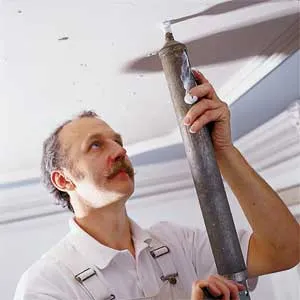We may be compensated if you purchase through links on our website. Our team is committed to delivering honest, objective, and independent reviews on home products and services.
Lime plaster has been a staple building material for thousands of years across many different cultures, from Japan to Europe. When the This Old House TV project house in Charlestown was built in 1865, the original plasterers used lime plaster.
These plasters crystallize over a long period, are flexible, and resist water damage, making them a great candidate for repairs. With maintenance, they’ll last forever and age gracefully.

Common Issues with Historic Plaster
These are a few of the issues you might face with old plaster:
- Water damage: Water is the most destructive force to plaster. Leaks from roofs, pipes, and exterior walls soften the plaster, causing it to swell and eventually crumble. Aside from fixing the damaged plaster, you’ll also need to find where the water is coming from and patch it up.
- Vibration damage: The Charlestown house dealt with increased traffic nearby, which sent vibrations radiating through the area and weakened the bond between the plaster and lath.
- Paint issues: Different paint layers applied over many years can turn problematic, since different paints expand and contract at different rates. For example, modern paint can peel and flake traditional calcimine.
Essential Tools and Materials for Plaster Restoration
Before you start restoring your old plaster, have these tools on hand:
- Adhesive injection tools
- Lime putty and gypsum
- Mixing buckets and paddles
- Plaster trowels and spatulas
- Plaster washers and screws
- Protective gear (gloves, goggles, dust mask)
- Sandpaper and sanding blocks
Techniques for Reattaching Loose Plaster in a Historic Home
The specific repair techniques you’ll use will depend on what problems you’re dealing with. Take a look at the plaster and assess its condition as your first step. Drill a few small holes and measure the distance between the plaster and the lath. This will help you determine if the plaster’s still attached or if it’s separated.
Choosing the Right Plaster Mix
Your repair plaster’s composition can make or break a restoration project. For general repairs, a mixture of lime putty and gypsum works well. However, for more specialized repairs, such as cornice work, you may need to adjust the ratio of lime to gypsum. Higher gypsum levels set more quickly and are stronger for detail work.
Reattaching Separated Plaster
If the plaster has separated from the lath, you can use specialized adhesives to reattach it. The process involves injecting the adhesive under pressure through small holes drilled in the plaster. After injection, clamp the area with screws and washers to hold the plaster in place as the area sets.
Raking and Filling Holes and Cracks
To fix cracks and holes, start by raking out the damaged areas to create a clean, slightly widened surface for the new plaster to stick to. Carefully remove loose material with a specialized raking tool or utility knife. Once the area is clean, fill it with the new soft plaster, keeping it flush with the surrounding surface.
Removing Old Paint and Repainting the Plaster
If multiple layers of incompatible paint have made the plaster suffer, you can remove them with a wallpaper steamer. This method is especially useful for modern paints over traditional calcimine.
Once the old paint is gone, wash the plaster and let it dry completely. Choose a breathable lime-based paint that’s compatible with the plaster to prevent future peeling and moisture problems.
Repairing and Recreating Medallions
Damaged medallions require delicate repair. The process to repair them may involve removing paint layers, creating a mold, and casting a new medallion as necessary.
Cornice work can also suffer from water damage or holes left by old fixtures. Repair them with a high-gypsum plaster mixture. As it begins to set, recreate the cornice profile with a miter rod.
Dealing with Water Damage
Identify water-related issues as soon as you can for best results. Some signs include the following:
- Bubbling paint
- Discoloration
- Faulty plumbing nearby
- Ongoing roof leaks nearby
- Poor exterior drainage
- Soft spots in the plaster
You’ll need to address the moisture at the source for these repairs, not just fix the damaged plaster.
To protect your plaster from future moisture damage, follow these tips:
- Address any plumbing leaks promptly.
- Apply water-resistant sealants to exterior masonry when it’s appropriate.
- Maintain gutters and downspouts to direct water away from the building.
- Make sure high-humidity spaces are properly ventilated.
- Use dehumidifiers in damp basements and crawl spaces.

